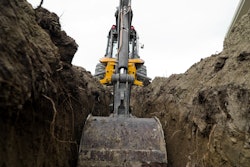
Editor's Note: This article was updated May 29, 2025, to reflect the public comment period has closed and an informal public hearing has been scheduled.
A proposed federal heat rule that would affect construction, among other industries with workers in high temperatures, has been published in the Federal Register.
(A public comment period for the proposal closed January 14, 2025. An informal, virtual public hearing is set to begin at 9:30 a.m. ET June 16. The hearing can be viewed online without registering. Instructions for watching the hearing will be posted on OSHA's rulemaking webpage.)
Contractor associations have criticized the proposal from the U.S. Occupational Safety & Health Administration as too rigid. The American Road & Transportation Builders Association said the published version still needs altering.
“ARTBA's previous concerns about the need for flexibility and tailored approaches were largely overlooked by the agency,” the association says. Despite concerns, construction groups have also noted that most contractors are already following the rules, which involve providing cooling areas, breaks, water, and a period of acclimatization for new workers or those returning to work after time off.
What Does the Proposal Say?
The proposal has two triggers, when heat indexes reach 80 degrees and when they reach "high heat" of 90 degrees and above.
Employers are required to monitor heat indexes and weather conditions to determine when workers need protection. In determining the heat index, which encompasses heat and humidity, contractors can follow local weather reports. They can also measure on site the heat index or measure the wet globe bulb temperature, which consists of temperature, humidity, air velocity and radiant heat from sunshine.
Starting at a heat index of 80 degrees, the proposal calls for:
- Each worker to have access to at least 1 quart of cool water every hour.
- Shaded – or if working inside, air-conditioned – break areas.
- An acclimatization plan for the first week for new employees or those returning after 14 days off.
- Paid rest breaks, if needed.
- Regular communication between employers and employees about heat hazards.
When the heat index hits 90 degrees or higher, employers are required to:
- Provide paid rest breaks of at least 15 minutes every two hours in the cool break areas. (An unpaid meal break can also count as a rest break.)
- Look out for signs and symptoms of heat-related illness. It calls on the “buddy system,” or each supervisor can observe up to 20 employees.
- Have two-way communication with employees who are alone at a jobsite at least every two hours.
- Alert employees of the heat hazard and provide information on drinking water, rest breaks and emergency-response procedures.
All affected employers are required to, regardless of heat index:
- Develop a written, site-specific heat injury and illness prevention plan, if they have more than 10 employees.
- Identify heat hazards.
- Develop heat illness and emergency-response procedures.
- Provide initial and annual refresher training for supervisors and employees on heat-related illness prevention.
- Provide supplemental training after changes in exposure to heat hazards, policy and procedure changes, and an occurrence of a heat injury or illness at the jobsite.
- If working indoors, keep six months of on-site heat measurement records in written or electronic form.
The below OSHA chart provides an overview of the proposed rules under each condition:
 The chart above outlines the provisions of OSHA's proposed heat rule. Note: "Initial Heat Trigger" is a heat index of 80 degrees. "High Heat Trigger" is a heat index of 90 degrees.U.S. Occupational Safety & Health Administration
The chart above outlines the provisions of OSHA's proposed heat rule. Note: "Initial Heat Trigger" is a heat index of 80 degrees. "High Heat Trigger" is a heat index of 90 degrees.U.S. Occupational Safety & Health Administration












